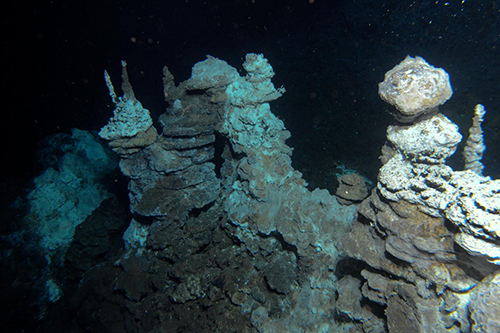![Image of a hydrothermal vent field along the Arctic Mid-Ocean Ridge, close to where 'Loki' was found in marine sediments. [Centre for Geobiology (University of Bergen, Norway) by R.B. Pedersen]](https://genengnews.com/wp-content/uploads/2018/08/91201_web1002162514-1.jpg)
Image of a hydrothermal vent field along the Arctic Mid-Ocean Ridge, close to where ‘Loki’ was found in marine sediments. [Centre for Geobiology (University of Bergen, Norway) by R.B. Pedersen]
Few areas in biology are as contentiously debated as how simple cells such as bacteria evolved into complex eukaryotic cells that comprise all of the species within the animal kingdom. However, a new discovery from scientists at Uppsala University in Sweden could represent the missing link to complex life.
When Archea burst onto the biological scene more than forty years ago, the scientific community was stunned that it represented a new and separate branch in the evolutionary tree of life. Despite their simplistic appearance, researchers found that these organisms had more in common with eukaryotes than simple bacteria—a conundrum that scientists have wrestled with for decades.
Although, this current discovery of a new group of Archea, called Lokiarcheaota (Loki for short), has researchers hypothesizing that these organisms may have been part of the bridge to greater cell complexity.
“The puzzle of the origin of the eukaryotic cell is extremely complicated, as many pieces are still missing,” explained Thijs Ettema, Ph.D., assistant professor in the Department of Cell and Molecular Biology at Uppsala University and senior author on the current study. “We hoped that Loki would reveal a few more pieces of the puzzle, but when we obtained the first results, we couldn't believe our eyes. The data simply looked spectacular.”
The findings from this study were published recently in Nature through an article entitled “Complex archaea that bridge the gap between prokaryotes and eukaryotes.”
Once obtaining samples of Loki, Dr. Ettema and his team were able to perform deep metagenomic sequencing analysis in order to obtain the much needed genetic information on the archeal linage.
“By studying its genome, we found that Loki represents an intermediate form in-between the simple cells of microbes, and the complex cell types of eukaryotes,” said Dr. Ettema. Additionally, Lionel Guy, Ph.D., senior research associate in Dr. Ettema’s laboratory and co-author on the current study added that “Loki formed a well-supported group with the eukaryotes in our analyses.”
After scanning through the piles of genomic data from their study, Anja Spang, Ph.D., postdoctoral researcher in Dr. Ettema’s laboratory and co-lead author on the study stated that “We found that Loki shares many genes uniquely with eukaryotes, suggesting that cellular complexity emerged in an early stage in the evolution of eukaryotes.”
The name Lokiarchaeota was derived from the hostile environment close to where it was found, Loki's Castle, a hydrothermal vent system located on the Mid-Atlantic Ridge between Greenland and Norway at a depth of 2,352 meters. The environment is thought to have a major influence on Loki’s unique evolution.
“Hydrothermal vents are volcanic systems located at the ocean floor. The site where Loki is heavily influenced by volcanic activity, but actually quite low in temperature,” said Steffen Jørgensen, Ph.D., research fellow at the University of Bergen in Norway and co-author on the study.
“Extreme environments generally contain a lot of unknown microorganisms, which we refer to as microbial dark matter,” says Jimmy Saw, Ph.D., postdoctoral researcher in Dr. Ettema’s laboratory and co-lead author of the paper.
Dr. Ettema and his team are excited by their findings and are looking to explore more of the microbial dark matter to try and uncover more clues about how complex cells may have evolved.
“In a way, we are just getting started. There is still a lot out there to discover, and I am convinced that we will be forced to revise our biology textbooks more often in the near future,” concluded Dr. Ettema.







